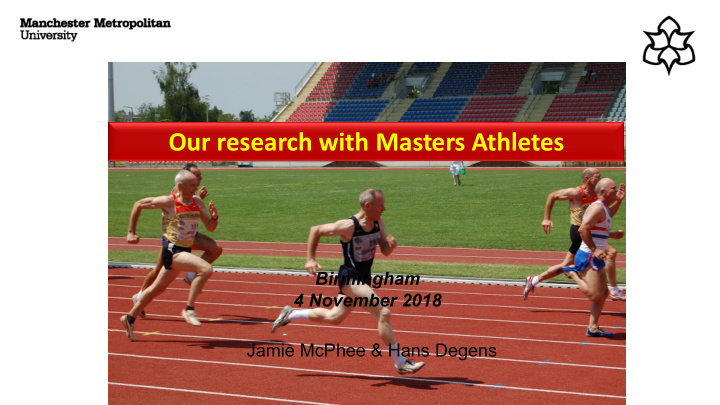



Our research with Masters Athletes Birmingham 4 November 2018 Jamie McPhee & Hans Degens
Overv rview I. Key research questions (and answers!) II. Key messages
A systematic approach to le learning about physical performance of f Masters Ath thletes 2002 - 2018
People move le less in in old lder age C. Elegans (Ingram, MSSE 32:1623, 2000; McPhee et al., BGEN, 17:567, 2016)
Physical fi fitn tness declines with age (Degens & McPhee, Chapter 20 in: Inflammation, Advancing Age and Nutrition, 2013)
Masters ath thletes are more active th than age- matched non-athletes (*gravity. Logarithmic scale) Accelerometry counts Three times more active Twenty times more active Two Hundred times more active MAC: Master Athlete Cohort. Compared with three different samples of the general population. Hannam et al 2016. Ost Intl
Masters Ath thletes are fi fit t and healthy “Fitness” is best measured as the amount of oxygen the body can use per minute (to make energy for moving).
Masters Ath thletes perform well 40 400 0 m Han ans De Degens 20 2008 08 EVACS Lju Ljublj ljana sam same as as th that of of th the win inning 85 85-year old old man an in in 200 2007!!! (Tanaka & Seals, J Physiol 586:55, 2008) 1896: First modern Olympic games (Athens)
Masters Athle letes are fit it and and healthy ‘Rejuvenation’ of VO 2 max in master athletes (Tanaka et al., JAP 83:1947, 1997)
Masters Athle letes have la larger muscle les and lo lower body fat ES: Early starter master athletes (trained all adult life) LS: Late starter master athletes (trained since age 50) C: Non athlete (Piasecki et al., Physiol Rep 4:E12987, 2016)
‘ Rejuvenation ’ of power in master athletes (Pearson et al., MSSE 34:1199, 2002)
Masters Ath thletes do not t have better balance th than age-matched non-athletes? Stand on one leg with eyes closed: 27 sec 5 sec 7 sec 30 * 25 * Medio-lateral sway (cm) 20 15 10 5 0 Y O MA (Leightley et al JAPA 25:345, 2017)
Masters Ath thletes have good bones Tennis arm vs non-tennis arm (Ireland et al., Osteoporosis Int, 2014; Piasecki et al., Scan J Sport Med, 2018)
Do Masters Ath thletes may have slightly better lu lung function fu 1 18 2 16 D L CO adj (mmol·kPa -1 ·min -1 ) 14 2 12 10 8 6 4 2 0 YC YA OC OA (Degens et al., Int J Sport Med, 2013)
Does it it matter at t what age a Master Ath thlete started competing? Trained all adult life Total 50 yr training Started training in middle-age Total 20 yr training 1.5 1.0 0.5 0.0 0 10 20 30 40 50 60 70 80 Age (yrs)
It It does not matter at t what 140 age a Master Ath thlete Control 120 started competing Master 30% Function (arbitrary units) 100 80 At any age masters athletes have better function than non-athletes 60 40 20 0 0 50 100 150 (Degens, Sport Med Doping Studies, 2012) Age (years)
The ri risk of f in injury ry during competition is is lo low (Ganse et al., JMNI, 2014)
Key messages • Muscle and strength large gain • Muscle and strength small gain • Bone strength large gain • Bone strength small gain • Metabolism and fatness moderate gains • Metabolism and fatness big gains • Cardiovascular gains (VO 2 max) • Cardiovascular gains (VO 2 max) • Performance gains discipline-specific • Performance gains discipline-specific Balance can be improved!
Acknowledgements International Collaborators: • Prof J Rittweger: German Aerospace Institute, Cologne • Dr MT Korhonen: University of Jyvaskyla, Finland • Dr B Ganse: University Hospital Aachen, Germany Colleagues: • Dr A Ireland: Manchester Metropolitan University • Dr J Coulson: Manchester Metropolitan University • Dr M Piasecki: Manchester Metropolitan University
Thank you for your attention
Recommend
More recommend